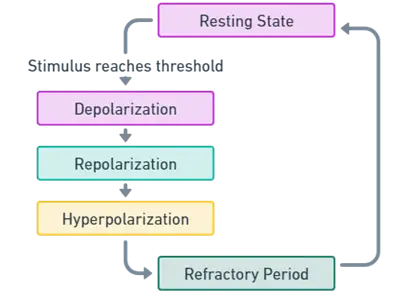- A nerve impulse, also known as an action potential, is an electrical signal that travels along the nerve cells or neurons in the nervous system.
- It is the fundamental mechanism through which neurons communicate with each other and transmit information.
- Nerve impulses are crucial for processing sensory input, generating motor output, and enabling higher cognitive functions such as learning and memory.
Here’s an overview of how a nerve impulse is generated and transmitted:
This is a sample ad placement!
1. Resting state:
- Neuron at resting membrane potential, around -70 mV.
2. Stimulus and depolarization:
- External stimulus cause local depolarization; if threshold is reached, voltage-gated Na+ channels open, leading to a rapid increase in membrane potential.
This is a sample ad placement!
3. Propagation:
- Nerve impulse travels along the axon as depolarization opens voltage-gated Na+ channels in adjacent regions.
4. Repolarization:
- Voltage-gated K+ channels open, allowing K+ ions to exit, restoring membrane potential back to resting state.
This is a sample ad placement!
5. Refractory period:
- Neuron enters a period where generating another action potential is difficult or impossible, ensuring unidirectional propagation of nerve impulses.
6. Synaptic transmission:
- It triggers neurotransmitter release at the synaptic terminal, influencing the postsynaptic neuron’s membrane potential.

Thank you for reading from Firsthope's notes, don't forget to check YouTube videos!
This is a sample ad placement!

